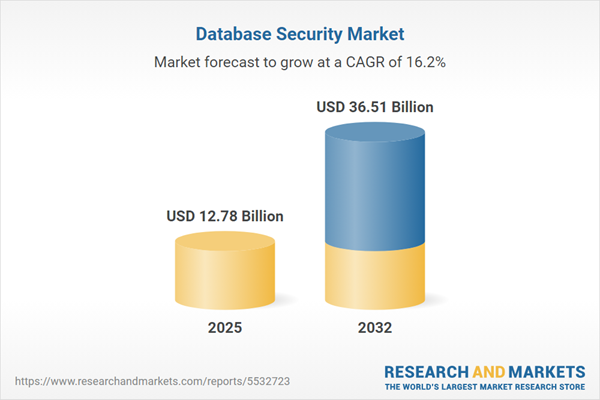Speak directly to the analyst to clarify any post sales queries you may have.
The database security market is advancing rapidly as enterprises realign cybersecurity priorities to safeguard sensitive data, meet evolving compliance obligations, and mitigate emerging risks posed by the acceleration of digital transformation.
Market Snapshot: Database Security Market Size and Growth
Fueled by strategic enterprise investment in advanced cybersecurity and compliance-driven tools, the global database security market is demonstrating robust growth dynamics. In 2024, the market was valued at USD 11 billion, and it is expected to reach USD 12.78 billion by 2025 and USD 36.51 billion by 2032.
Key trends driving this expansion include widespread adoption of hybrid and multi-cloud infrastructures, growing regulatory demands, and an urgent need for unified security frameworks. Organizations are responding to an increasingly complex threat environment with agile, scalable security postures that bridge traditional and emerging IT architectures.Scope & Segmentation of the Database Security Market
Senior IT leaders are optimizing database security strategies through targeted investments and a nuanced understanding of the following core market segments, technologies, and regional shifts:
- Product Types: Activity monitoring delivers real-time threat insight. Auditing tools fulfill compliance and accountability mandates. Encryption safeguards confidential information, while firewalls establish strong security perimeters. Data masking supports privacy initiatives, and key management ensures authorized-only access to critical assets.
- Deployment Modes: Cloud-based solutions bring scalability and agility to support business transformation. On-premises implementations enable greater control for sector-specific compliance and ensure local data residency where needed.
- Organization Size: Large enterprises manage complex, integrated security environments. Small and midsize firms require customizable, resource-efficient security designed to match evolving operational needs and budgets.
- Industry Verticals: Sector-specific requirements shape adoption among industries including financial services, healthcare, government, retail, insurance, and telecommunications, each facing distinct data protection and compliance mandates.
- Service Types: Managed services provide round-the-clock threat monitoring and rapid incident response. Professional services facilitate deployment, integration, and user training to maintain strong security postures over time.
- Regions: The Americas, Europe, Middle East and Africa, and Asia-Pacific exhibit varying priorities based on local digital transformation rates, regulatory frameworks, and security investment patterns.
- Key Companies: Major providers such as IBM, Oracle, Cisco, Imperva, McAfee, Broadcom, Check Point, Trend Micro, Fortinet, and Micro Focus supply robust platforms suited to distinct enterprise and compliance requirements.
Key Takeaways for Database Security Decision-Makers
- Unified security suites enable seamless defense coordination across hybrid, multi-cloud, and legacy systems, simplifying management of compliance and risk exposure.
- Integrated monitoring and advanced encryption increase visibility of emerging cyber threats and support rigorous international and sector-specific data protection standards.
- Implementation of zero trust models and segmentation helps confine unauthorized activity and limits the impact of security breaches within the organization.
- Intelligent automation and artificial intelligence within incident response platforms improve accuracy in detection and free up security teams for higher-value strategic actions.
- Flexible deployment options allow organizations to realign security investments as operational models and compliance requirements change.
- Proactive monitoring of global regulatory trends enables organizations to remain ahead of evolving compliance landscapes and reinforce long-term business resilience.
Tariff Impact on Database Security Procurement
Recent tariffs in the United States are prompting a reassessment of procurement approaches in the database security segment. Companies are diversifying suppliers, exploring open-source or locally developed solutions, and considering adaptable subscription-based models to limit international supply chain risks and maintain compliance. This flexibility is essential for upholding strong data protection even as trade and policy dynamics change.
Methodology & Data Sources
This analysis is based on interviews with executives, IT procurement authorities, and security experts. The report integrates proprietary market research, third-party analytics, and ongoing input from stakeholders to deliver an accurate and actionable view of database security challenges, adoption patterns, and innovation.
Why This Report Matters
- Guides IT and security leaders in building frameworks that address diverse compliance requirements and ensure operational continuity across varied environments.
- Helps procurement and operations teams stay adaptive amid shifting regulatory and market scenarios, supporting enterprise readiness and stability.
- Offers a clear, objective basis for decision-makers to compare vendor solutions against emerging technology and compliance needs.
Conclusion
Comprehensive and agile database security strategies are essential for protecting sensitive information, responding to regulatory changes, and fostering stakeholder confidence in a rapidly evolving digital environment.
Additional Product Information:
- Purchase of this report includes 1 year online access with quarterly updates.
- This report can be updated on request. Please contact our Customer Experience team using the Ask a Question widget on our website.
Table of Contents
3. Executive Summary
4. Market Overview
7. Cumulative Impact of Artificial Intelligence 2025
Companies Mentioned
The companies profiled in this Database Security market report include:- IBM Corporation
- Imperva, Inc.
- Oracle Corporation
- McAfee LLC
- Cisco Systems, Inc.
- Broadcom Inc.
- Check Point Software Technologies Ltd.
- Trend Micro Incorporated
- Fortinet, Inc.
- Micro Focus International plc
Table Information
| Report Attribute | Details |
|---|---|
| No. of Pages | 197 |
| Published | October 2025 |
| Forecast Period | 2025 - 2032 |
| Estimated Market Value ( USD | $ 12.78 Billion |
| Forecasted Market Value ( USD | $ 36.51 Billion |
| Compound Annual Growth Rate | 16.1% |
| Regions Covered | Global |
| No. of Companies Mentioned | 11 |









